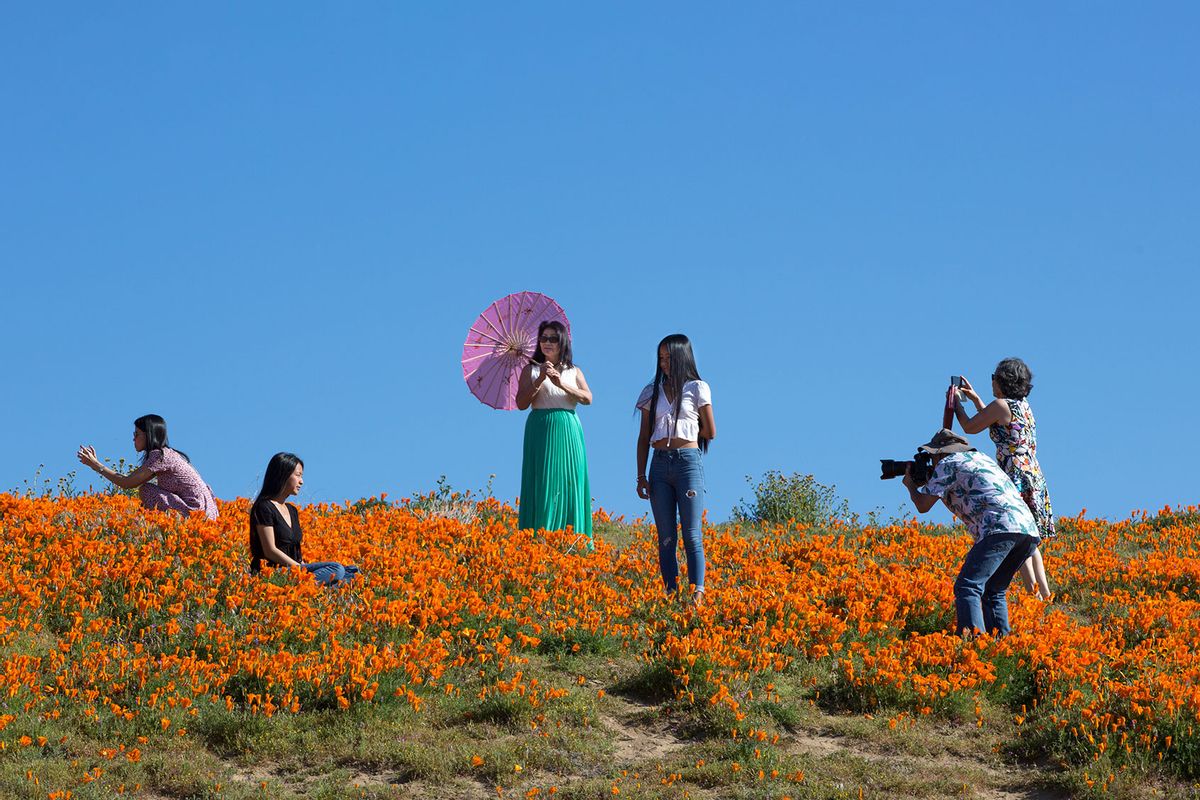California’s rare flowering “superbloom” at risk of being trampled to oblivion by unruly tourists

After several weeks of weird, record-breaking winter storms, California is anticipating another “superbloom” this spring, a rare phenomenon when Southwestern deserts and hills are carpeted in brilliant wildflowers. Superblooms only trigger under precise conditions, but the explosion of blossoms can be so intense that splotches of orange and yellow are visible from space.
These events, which usually peak in late March, can feature everything from desert dandelions to evening primrose to lavender lupine — and of course, plenty of apricot-colored California poppies, the official state flower.
“We’ve seen that the public have not shown restraint in the pursuit of the perfect picture for social media.”
While not technically a botanical term used by plant experts, superblooms are a popular trending topic on social media, with hundreds of thousands of posts on Instagram and TikTok depicting lush meadows teeming with flowers. In 2019, the year of California’s last major superbloom, tourists overwhelmed the hills of Lake Elsinore, as well as Joshua Tree National Park, Lake Tahoe and the Santa Monica Mountains. Many sightseers were seeking that Instagram-perfect snapshot of natural beauty. But such things can come at a cost to nature.
“The flora of California is magnificent. About a third of the [plant] diversity in California are these annual plants that only show themselves when there’s ample precipitation. Otherwise, they’re lying dormant in the soil seed bank,” Naomi Fraga, the director of conservation programs at the California Botanic Garden in Claremont, told Salon. Fraga, who has been studying rare native plants in the state for two decades, says every time the rains get heavy enough, her department fields calls anticipating the next superbloom.
Fraga describes superblooms as showcasing “hidden diversity” that only reveals itself in years of intense rain. Gorgeous buds aren’t a bad reprieve from California’s recent drought, either. “Your senses get overwhelmed by just the sheer mass of flowers all blooming at the same time,” Fraga said.
But botanists like Fraga and other plant experts are trying to encourage folks to skip the superbloom this year, or at least exercise some extreme restraint. That’s because these floral ecosystems are fragile, stressed and repeatedly damaged by careless “nature enthusiasts” who go off-trail, trampling the plants and spreading the seeds of invasive species.
It’s true that witnessing a superbloom can be spectacular. But if people really care about it, they shouldn’t follow the crowds stomping on these plants, leaving trash and clogging up traffic.
“We’ve seen that the public have not shown restraint in the pursuit of the perfect picture for social media,” Fraga said. “It’s this very transactional interaction where people are seeking to get something from nature and to have that moment, that interaction, but they’re not thinking about how their desire for that moment has an impact on the environment.”
Echoing this sentiment, on February 7, Natasha Johnson, the mayor of Lake Elsinore, announced at a press conference that Walker Canyon, a locale blanketed by a superbloom in 2019, would be closed to the public this year. Trespassers were threatened with arrest to avoid what Johnson described as her community being swamped with “Disneyland-sized crowds” numbering as many as 100,000 people in a single weekend. The so-called “poppy apocalypse” gridlocked the Riverside County city, population 70,000, and resulting in the death of a police officer, who was struck by an intoxicated driver.
“We know people want to see a beautiful sea of color,” Johnson said. “We also want the land in our community to thrive.”
Want more health and science stories in your inbox? Subscribe to Salon’s weekly newsletter The Vulgar Scientist.
Fraga isn’t interested in shaming people, but does want to educate folks on the fragile beauty of these sporadic blossoms. Going off the trail is generally where the trouble starts. Crushing the reproductive aspects of plants means that the next generation could be diminished.
“And once you have numerous people creating these user trails and walking in the same area, then that might actually degrade that habitat for those flowers to be able to grow in that area in future years,” Fraga said. “People walk around lots of different places, and they might be carrying around weed seeds in their shoes, and inadvertently be spreading invasive species around.”
“I just wish that people could maybe adjust their expectations for what they think nature should be providing every year. That’s a lot to ask for, like a superbloom every year.”
Despite their stunning displays, Fraga describes these state parks as “boutique ecosystems” that are a shadow of what they once were. For example, Carrizo Plain National Monument, one of the prime wildflower spots in California, was once a massive grassland populated by antelope and elk. Today, it is a mere 200,000 acres, which is less than it sounds, shriveled up by surrounding agriculture and development. In 2020, federal officials approved an oil well and pipeline within the monument, which is also host to several massive solar power plants.
“We’ve marginalized these habitats so much already. And we’re marginalizing them further by loving them to death,” Fraga said. “So how can we get people to recognize that and show restraint, if they want them to exist into the future?”
Fraga says that superblooms can overshadow appreciation for other plants, like the perennials that thrive in California year-round. “It’s always exciting for me to see even just a few flowers,” Fraga said. “I just wish that people could maybe adjust their expectations for what they think nature should be providing every year. That’s a lot to ask for, a superbloom every year.”
Fraga also encourages people to garden, creating their own lush landscapes that don’t involve traveling. By planting local plants, you can also support native pollinators, finding that spark or connection to nature in a less vain and consumptive manner.
“I know it’s not the same [as a superbloom.] We can get our thrills in a variety of ways, I suppose,” Fraga said. “I’d just like people to ask themselves, what is it that they’re seeking? And what are their motivations for their visit? And consider what the impact is.”
Read more
about southwest conservation


